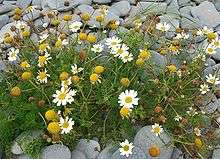Tripleurospermum maritimum
| Tripleurospermum maritimum | |
|---|---|
 | |
| Scientific classification | |
| Kingdom: | Plantae |
| (unranked): | Angiosperms |
| (unranked): | Eudicots |
| (unranked): | Asterids |
| Order: | Asterales |
| Family: | Asteraceae |
| Tribe: | Anthemideae |
| Genus: | Tripleurospermum |
| Species: | T. maritimum |
| Binomial name | |
| Tripleurospermum maritimum (L.) W.D.J.Koch | |
| Synonyms | |
|
Matricaria maritima L. | |
Tripleurospermum maritimum (syn. Matricaria maritima[1]) is a species of flowering plant in the aster family commonly known as false mayweed[2] or sea mayweed. It is found in many coastal areas of Northern Europe, including Scandinavia and Iceland, often growing in sand or amongst beach pebbles.
As with many maritime plants, sea mayweed has fleshy leaves which help it to survive in the harsh salty environment. The leaves are divided into short segments. When crushed, they yield a sweet smell similar to that of its relative chamomile, though much fainter.
The daisy-like flowers usually appear between July and September and can reach up to 50 mm across. The stems of the plant are frequently tinged red towards the base.
In Iceland, sea mayweed is known as Baldr's eyelashes (baldursbrá), though this name is also given to scentless mayweed in Norway and Sweden.
References
- ↑ Tripleurospermum maritimum (L.) W.D.J. Koch subsp. maritimum false mayweed, Plants Database, usda.gov
- ↑ "Tripleurospermum maritimum". Natural Resources Conservation Service PLANTS Database. USDA. Retrieved 15 December 2015.
External links
![]() Media related to Tripleurospermum maritimum at Wikimedia Commons
Media related to Tripleurospermum maritimum at Wikimedia Commons